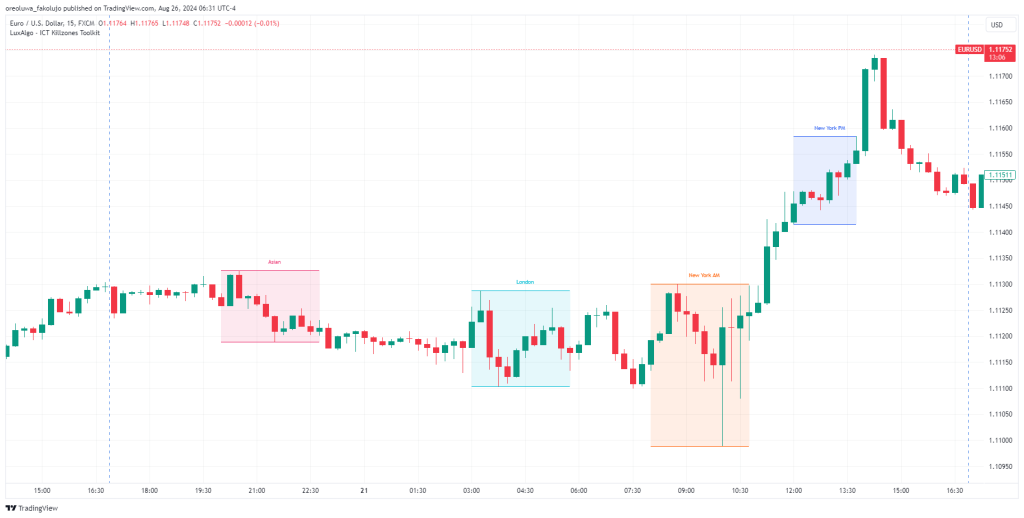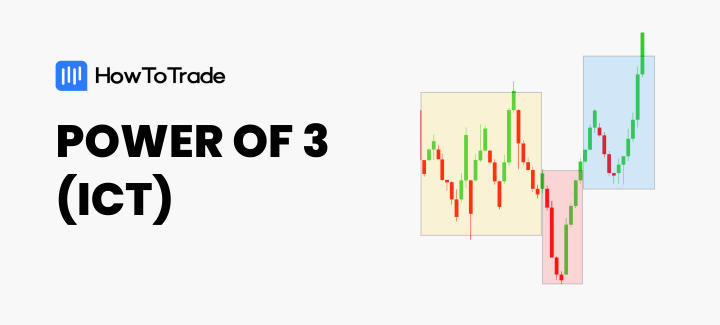
- ICT Killzones are specific timeframes in the forex market that highlight increased volatility and trading volume.
- The four primary Killzones – Asian, London, New York, and London Close – each offer unique trading opportunities for various trading pairs and markets.
- Don’t forget to monitor economic news releases and adjust for Daylight Saving Time to maximize the effectiveness of your strategies during ICT Killzones.
ICT Killzones represent specific periods when market activity and trade volume are at their peak, largely due to the business hours of major financial hubs. They were popularized by Michael Huddleston, the “Inner Circle Trader.” Recognizing these periods and timing your trades according to them helps you take advantage of market volatility and spot high-probability trade setups.
In this blog post, we’ll show you:
- What ICT Kill zones are
- The four principal ICT Killzones and their timings,
- How Daylight Saving Time affects these timings, and
- How to set them up on your trading platform.
 Table of Contents
Table of Contents
What are ICT Kill Zones?
In the forex market, ICT Killzones refer to distinct trading intervals with elevated activity and substantial trade volumes. During these windows, volatility spikes considerably. Many traders optimize their market entries and exits to coincide with intensified price fluctuations. These critical periods are based on the international forex trading hours (Sydney, Tokyo, London, and New York)
Four primary kill zones stand as pivotal periods during which both trading volume and market volatility tend to surge. These periods align closely with the trading sessions of institutional traders on major trading floors worldwide, thereby shaping market trends. And you’ll notice intensified potential for volatility, especially during ICT Killzones’ overlapping times.
What are the Primary ICT Killzone Times?

The four main ICT Kill Zones are the Asian Kill Zone, the London Kill Zone, the New York Kill Zone, and the London Close Kill Zone. Each offers distinct attributes and opportunities for successful trades.
| Kill Zone | Timeframe (EST) | Characteristics | Strategy Considerations |
| Asian Kill Zone | 7 PM – 10 PM | * First major market to open (Tokyo session). * Lower liquidity and volatility. * Sets the tone for subsequent sessions. | * Suited for range-bound strategies. * Identify setups for the London session. |
| London Kill Zone | 2 AM – 5 AM | * The most liquid session (London open). * High volatility and sharp price movements. * Overlaps with the end of the Asian session. | *Ideal for breakout strategies. *Focus on EUR, GBP, CHF pairs. |
| New York Kill Zone | 7 AM – 10 AM | * High liquidity and volatility (New York open). * Overlaps with London session. * Key U.S. economic data releases. | * Trade news events. * Capitalize on trends from the London session. |
| London Close Kill Zone | 11 PM – 1 PM | * Represents the final hour of the London session. * Lower liquidity as European markets close. * Potential for intraday trend reversals. | * Close positions from earlier sessions. * Look for trend reversals or consolidation. |
Let’s take a closer look at each:
1. Asian Kill Zone
The period between 19:00 EST and 22:00 EST is known as the Asian Kill Zone. This time remains consistent throughout the winter and summer seasons. The active currency pairs during this timezone are the AUD, NZD, and JPY currency pairs, which also derive some volatility from the Australian and New Zealand economic data releases.
Characteristics of the Asian Kill Zone
- One thing that makes the Asian Kill Zone special is that scalpers can aim for gains ranging from approximately 15 to 20 pips by exploiting range trading strategies.
- The Asian Kill Zone time is from 19:00 EST to 22:00 EST.
- The Asian Kill Zone corresponds to the Tokyo session, which is the first major market to open in the 24-hour forex trading cycle.
- You’ll often find lower liquidity and tighter trading ranges during this interval compared to the London and New York sessions.
- It’s also a common strategy for traders to use this Asian Kill zone to gauge the market’s initial direction for the day.
Take a look at the best currency pairs to trade during the Asian Session.
2. London Kill Zone
Occurring from 2:00 AM to 5:00 AM Eastern Time, the ICT London Kill Zone is a pivotal window for traders of EUR, GBP, and CHF currency pairs.
Characteristics of the London Kill Zone
- For those seeking to spot potential breakouts or directional changes, particularly within currency pairs that tend not to fluctuate much overnight, the London Kill Zone is your time.
- The London Kill Zone time is between 2:00 AM and 5:00 AM Eastern Time
- It aligns with the opening of the London session, the most liquid forex market session.
- It is especially notable for its influence on market direction. It frequently sets the day’s low point in bullish markets and, conversely, marks the high point during bearish conditions.
Check the best currency pairs that can be traded during the London session.
3. New York Kill Zone
The New York Kill Zone occurs within the period of 8:00 AM and 11:00 AM Eastern Time. In winter months, this is equivalent to 9:00 EST until 12:00 EST. In the summer months, it returns to the normal 8:00 AM to 11:00 AM Eastern Time.
Characteristics of the New York ICT Kill Zone
- It coincides with the opening of the New York session, one of the most important trading periods of the day.
- The significance of the New York Kill Zone lies in its overlap with the London trading session, which creates a pivotal opportunity for currency trades involving USD.
- The New York Kill Zone is a particularly crucial interval for dealing with major currency pairs linked to the dollar index and seizing opportunities presented by heightened market activity.
- The session often lays claim to up to 30 to 40 pips in price movements.
- Because you might see a retracement of the London session in the New York kill zone, traders often scout for Optimal Trade Entry Pattern trades here.
Take a look at the best currency pairs to trade during the New York session
4. London Close Kill Zone
The London Close Kill Zone spans from 11:00 EST to 13:00 EST, and in summer, it shifts earlier to run from 10:00 EST until 12:00 EST. This time frame is significant because it tends to reflect price reversals as traders realign their positions before trading ceases for the day.
Characteristics of the London Close Kill Zone
- Because of the market’s tendency to reverse during this time, it’s possible to scalp quick reversal trades during this time.
- The London Close Kill Zone goes from 10:00 EST until 12:00 EST.
- This is where the price is likely to peak on a bullish day and bottom on a bearish day.
- Traders usually close trades from the London and New York sessions during the London Kill Zone time.
ICT Killzones Trading PDF Free Download
If you need something to easily carry around and refer to when it comes to ICT Kill zones trading, this PDF is for you:
ICT Killzones Trading PDF Free Download
How Does Daylight Saving Time Affect ICT Killzones?
Daylight Saving Time (DST) impacts ICT Kill Zones, as it alters when major financial markets open and close. Since Kill Zones are tied to specific market sessions, any shift in the clock can lead to changes in the timing of these high-liquidity periods.
The Asian session is generally less affected by DST since most Asian countries do not observe it. However, the relationship between the Asian session and the London session can be impacted. For example, when the UK moves an hour ahead in the spring, the overlap between the Asian and London sessions will shift by an hour, potentially affecting the liquidity during the latter part of the Asian Kill Zone.
The London Kill Zone is directly influenced by DST, as the UK and much of Europe observe this practice. When UK DST begins on the last Sunday in March, the London Kill Zone shifts one hour earlier in relation to other time zones. This change means traders outside of Europe need to adjust their trading schedules to match the new timing. And when the UK DST ends on the last Sunday in October, the Kill Zone shifts back, requiring another adjustment.
The New York session is also affected by DST, as the U.S. observes it. When the U.S. moves the clocks forward in the spring (specifically the second Sunday of March), the New York Kill Zone time starts an hour earlier. This might reduce the overlap with the London session if the UK has not yet transitioned to DST. Conversely, in the fall, the Kill Zone shifts back an hour on the first Sunday in November, which can increase the overlap with the London session.
How Do You Set Up ICT Kill Zones on Trading Platforms?
Popular trading platforms like TradingView and MetaTrader 4 (MT4) allow you to define these kill zones, but not by default. You would have to rely on indicators on these platforms to set your kill zones up.
Configuring ICT Killzones on TradingView
There are many Kill zones and session indicators on the TradingView trading platform. All you need to do is search for “sessions” or “kill zone” among the indicators, and you’ll get more than enough.
However, one that’s most commonly relied on by traders is the LuxAlgo ICT KillZones Toolkit indicator. The indicator also allows you to use other ICT concepts, such as Fair Value Gaps and Market Structure Shifts. But if we’re being honest, there are so many indicators to choose from that do the job quite well. So, just pick one, make sure the timing is configured appropriately, and go to town.
Using ICT Killzone Indicators on MT4
A cursory search on the internet will also reveal many free Killzone indicator options. Once you download one, you must transfer the specific indicator file into the designated folder for indicators within MT4 before you can use it.
If you have a hard time adding custom indicators to MT4 or MT5, this piece will be of help:
How to Download and Install Custom Indicators to MetaTrader 4 and 5
Over To You
Understanding and leveraging ICT Killzones can significantly enhance the effectiveness of forex trading strategies as a day trader. But don’t forget that it’s only a concept. In addition to the ICT Killzones, you’ll also need to piece many other concepts together to find your trading edge. Good luck.
Risk Disclosure: The information provided in this article is not intended to give financial advice, recommend investments, guarantee profits, or shield you from losses. Our content is only for informational purposes and to help you understand the risks and complexity of these markets by providing objective analysis. Before trading, carefully consider your experience, financial goals, and risk tolerance. Trading involves significant potential for financial loss and isn't suitable for everyone.





